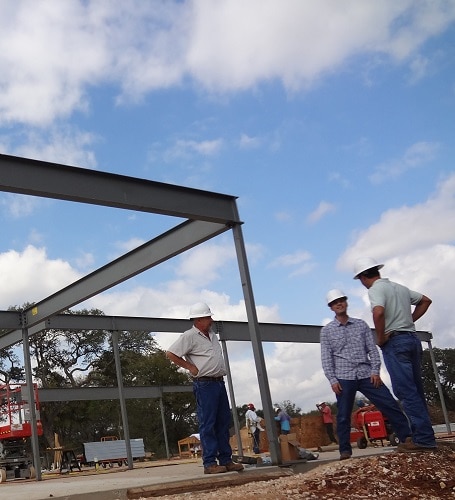
Once again we return to our So You Want My Job series, in which we interview men who are employed in desirable jobs and ask them about the reality of their work and for advice on how men can live their dream.
Plenty of men dive into architecture as little boys with LEGOs and Lincoln Logs, but eventually move on to other pursuits. Some men, however, never abandon that childhood hobby and go on to create and dream up buildings in real life versus on their bedroom floors. Folks like Ryan Hansanuwat of Austin, Texas, who was a high school dropout, and then went back to school when he was older than most, and now runs an architecture firm. Because of his non-traditional path into the job, Ryan started the Architecture Career Guide website in hopes of inspiring others interested in this field. Today Ryan fills us in on what his job is like.
1. Tell us a little about yourself (Where are you from? How old are you? Describe your job and how long you’ve been at it, etc.).
I am a 34-year-old registered architect practicing in the Austin, TX area. I have been in the industry in various forms for over ten years. My current role is as a Vice President of the architecture division of a small-to-mid-size firm that specializes in commercial architecture. In the past I have worked as a Project Architect, Project Manager, Designer, Drafter, and Intern.
I got started in junior college when I took an “Introduction to Architecture†class where I fell in love with the profession. I completed a professional Bachelor of Architecture degree at Cal Poly Pomona and continued on to get a Master of Building Science degree from the University of Southern California. Prior to completing my Master’s degree, I also completed my internship and licensing exams, but that is not typical. Most people can take anywhere from three to ten years after school to become an actual licensed architect.
2. Why did you want to become an architect? Have you always had a fascination with buildings? Did you play with LEGOs as a kid? When did you know it was what you wanted to do?
I didn’t realize I wanted to be an architect until I took the introductory class at junior college, but looking back, I could have figured it out earlier. I played with LEGOs all the time as a kid, I took my parents’ 100 Home Plans book and drew floor plans and pictures of dream houses. I also spent a lot of time building my own tree house, so in reality, being an architect was always in me, I just didn’t realize it until later in life.
3. How do you become an architect? Is it just a college degree, or are there other certifications needed?
To become a licensed architect, it is a three-step process, where you complete your education, experience, and examination. The typical way most people do this is to go through an architecture program at a university that is accredited by the National Association of Architecture Boards. Once you receive your degree, you must go through your internship years where you are required to get on-the-job education in specific areas, as defined by the Internship Development Program, which should take about three years.
Once you have the requisite education and experience you can start taking your licensing exams, called the Architecture Registration Exams. There are currently seven exams which test your ability to protect the health, safety, and welfare of the public, and range from space planning to structural systems and everything in between. Once you have passed all of your exams you are officially a licensed architect, but depending on your state, you will also still have to complete yearly Continuing Education hours to stay up to date with changes in the industry.
4. Most folks picture an architect, and see someone at a draft board all day coming up with cool building ideas. I’m sure that’s only partially accurate, however. What does your day look like? What are the different types of architects you can be?
The image of the artist staring at a drafting board is true in some respects, but it is really only a small portion of the job. For most architects, designing is the best part of the job, but we really spend very little time on that portion alone. A lot of times we have to run a business, do marketing, plan details, and we are constantly in meetings with owners, engineers, and contractors. I tend to spend the majority of my day on the phone/email and very little time on design.
That being said, there are so many different types of positions that an architect can fulfill. Some architects will focus on different markets that offer different aspects of the field. Residential architects work on custom homes for homeowners, while large commercial architects work in teams on huge projects like skyscrapers. Because it is so varied, architects can find their fit in just about any type of firm.
5. What is the job market like for architects? Are the majority of jobs in architecture firms? How difficult is it to land a job at a firm, and what kinds of things set an applicant apart from the pack?
The job market is getting better, but it is still competitive. When the recession came, a lot of architecture firms took a hit, and some are just now recovering. Because of that, there are only so many jobs at architecture firms to go around. While a lot of the jobs for those starting out are in existing firms, there are still a lot of architects who go out on their own, so there are still options out there.
To get a job at an architecture firm, it depends on the level you are coming in at. For interns and young architects, the best things you can do to set yourself apart are to have a good portfolio with great design, but also to know all of the right production tools like Autodesk Revit, or whatever the firm you are interested in uses, and to have a general understanding of how a building goes together. Experience in construction is good for the ability to understand details and construction methods.

6. How does an architect go into business for himself? How does an independent architect land a project?
Many architects eventually start their own firm, but for a lot it doesn’t happen until they have put many years into the industry. During this time they will learn all the aspects of architecture from design, to marketing, and construction. As architects start bringing in their own clients, at some point they decide if they want to get clients for themselves or their employer.
Once they have gone on their own, to find clients it depends on the project type. If you are working on smaller projects like custom housing, it is a combination of advertising, marketing, and just generally getting the word out and utilizing any connections you have. Commercial projects also have those same components, but many require you to be able to put together a good response to requests for qualifications, where you have to showcase your portfolio and abilities for the particular project in a specified format.
7. What is the work/life balance like?
Work/life balance is probably the biggest complaint from many architects, as the image is that you must sacrifice for your art. This is ingrained early on during architecture school and is oftentimes expected at work, where many all-nighters will be necessary to get the project done.
This is not always the case and doesn’t have to be either. I personally leave the office sometime around 5pm and eat dinner with my family every night. I spend my weekends with my family and only occasionally will I have to put in more than 40-45 hours per week.
8. What’s the best part of your job?
The best part of my job is the moment when people start using the building you designed. The fact that at one point, this building only existed in your mind and now people are getting satisfaction from the physical thing your mind was able to produce. I’m overjoyed when my clients talk about how the space has affected them positively and to know I could make a difference.
9. What’s the worst part of your job?
The worst part of my job are those rare occasions when I do pull all-nighters, or work 60-hour weeks for a deadline to get something done right. Many architects are perfectionists, and I’m no exception, so there are times when I feel the need to spend extra time on a project to have the best product possible.
10. What’s the biggest misconception people have about your job?
There are a few misconceptions depending on who you ask. One is the idea that we are willing to sacrifice everything for our jobs. From the book Fountainhead to the movie Click!, architects are often portrayed as idealistic and unwilling to work with clients, or even spend time with our families, which is not true for most of us. The other misconception is that architects are a luxury that only the rich can afford. Architects practice in so many different areas and there are so many of us, chances are you can find somebody who works on your specific project type that would love to work with you.
11. Any other advice, tips, commentary, or anecdotes you’d like to add?
After all of the years of schooling, working, testing, and learning to become an architect, the day your first design is built and you get to walk in it, all of it is worth it. Seeing something I designed in the real world, with real people using it, is the second proudest moment of my life. Second only to being a dad.
Tags: So You Want My Job

